A BIRTHDAY SALUTE: The late fan-favorite artist was born 64 years ago…

—
UPDATED 2/27/24: This tremendous list by Chris Franklin, first published in 2021, not only holds up exceptionally well, it’s inspired me to re-read all of Breyfogle’s Batman stories. It will probably have the same effect on you. Dig it. — Dan
—
The late, great Norm Breyfogle — born 62 years ago on Feb. 27, 1960 — left us too early in 2018, but his colorful and kinetic artistic legacy remains and seems to grow with every passing year.
Batman Knightcast podcaster Chris Franklin, a 13th Dimension regular, put together this outstanding tribute to one of the great Batman artists of the last 40 years.
Enjoy.
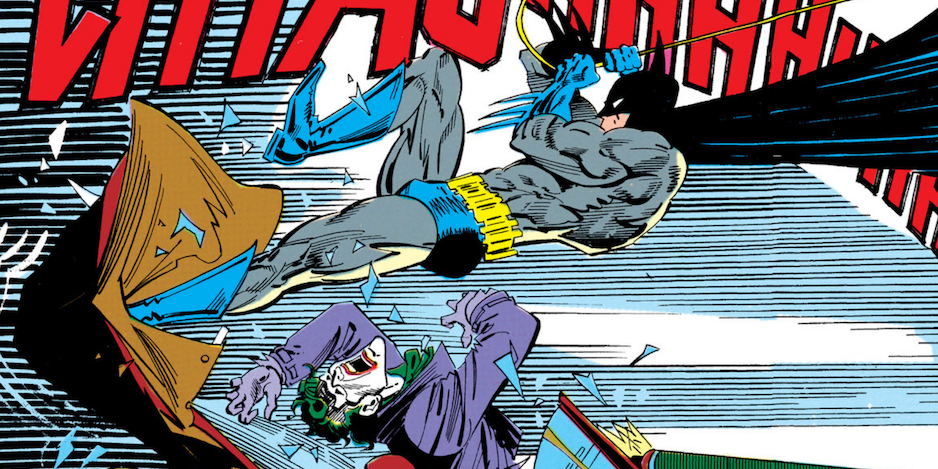
By CHRIS FRANKLIN
Norm Breyfogle (Feb. 27, 1960–Sept. 24, 2018) came onto the Batman titles like a bolt of lightning in 1987 with a unique interpretation of a Dark Knight who seemed to be able to shape-shift from hard, coiled muscles to ethereal shadow at will.
For a 12-year-old Batman fan like myself, it was a breath of fresh air, and his nearly month-to-month presence finally gave editor Denny O’Neil’s run some visual stability, after numerous creative fill-ins and short runs. With Batman stalwart Jim Aparo initially on Batman and Breyfogle on Detective Comics, fans of the Masked Manhunter had the best of both worlds: the familiar and tried-and-true, and the new and exciting, every month.
Breyfogle and his primary collaborator, writer Alan Grant, took Batman to places rarely explored in his previous 50 years, tackling social issues of the day in stories that were far more psychologically driven than standard mainstream fare. All this while battling new and exciting rogues, some of whom joined the upper echelon of Bat-villains primarily created in the 1940s.
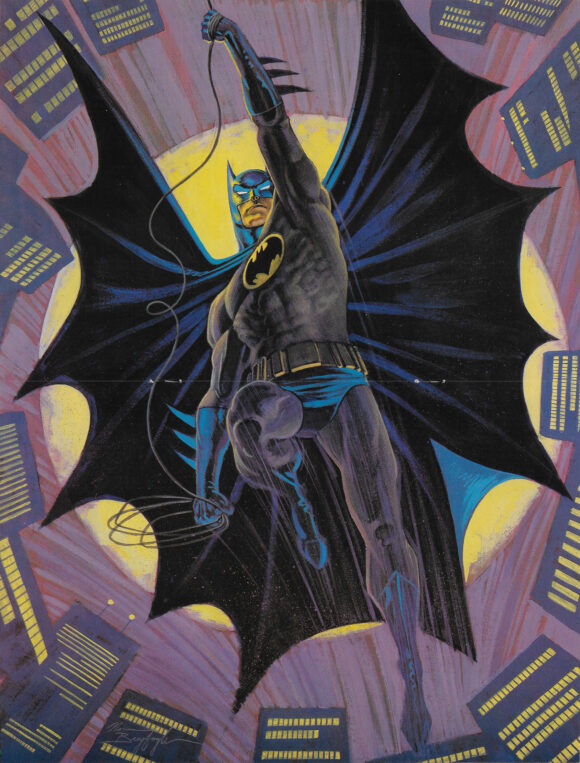
Poster from Detective Comics #604
Although he had a significant body of Bat-work under his utility belt, Breyfogle’s Batman would have become iconic just by its pure visual power alone. For a character with no shortage of great artists, Breyfogle stands tall on the Mt. Rushmore of Batman greats, owning the late ’80s and early ’90s, one of the character’s most popular eras.
To celebrate the date of his birth, let’s take a look at the TOP 13 NORM BREYFOGLE BATMAN STORIES – RANKED:
—
13. “Love Bird” (Batman Annual #11, 1987). Breyfogle’s debut in Gotham, and consequently, beleaguered Batman writer Max Allan Collins’ best Bat-tale, “Love Bird” finds the Penguin once again attempting to go straight, but this time he has a reason: the love of a good woman. Breyfogle’s art is a bit more grounded and less experimental than it will become in subsequent months, but his unique style is instantly apparent. His expressive faces give the story the proper light touch it needs, while he manages to bring iconic power to Batman and Jason Todd’s Robin.
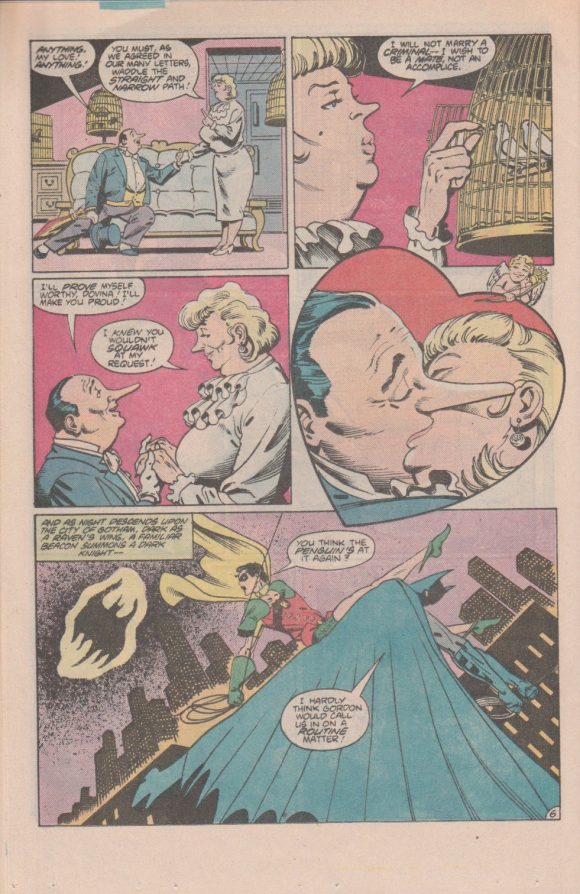
—
12. “Night People” (Detective Comics #587-589, June-Aug. 1988). Writing partners Alan Grant and John Wagner (although Wagner’s name was often just part of the byline, even if he didn’t contribute) weave a complex series of events together, making for one long night in the life of the Batman, and giving identity to new aspects of Gotham City.
The Dark Knight encounters drug dealers and customers, the death-obsessed crime boss named Kadaver, and most importantly, the hideous Corrosive Man, a new, more horrific take on Steve Englehart and Walt Simonson’s Dr. Phosphorus. Breyfogle’s art crackles with electricity and urgency as Batman is put through his paces. It evokes true pity for Mitchell, the skeletal, radioactive Corrosive Man, despite the body count he inadvertently racks up throughout the three-issue tale, not unlike that of a classic Universal movie monster.
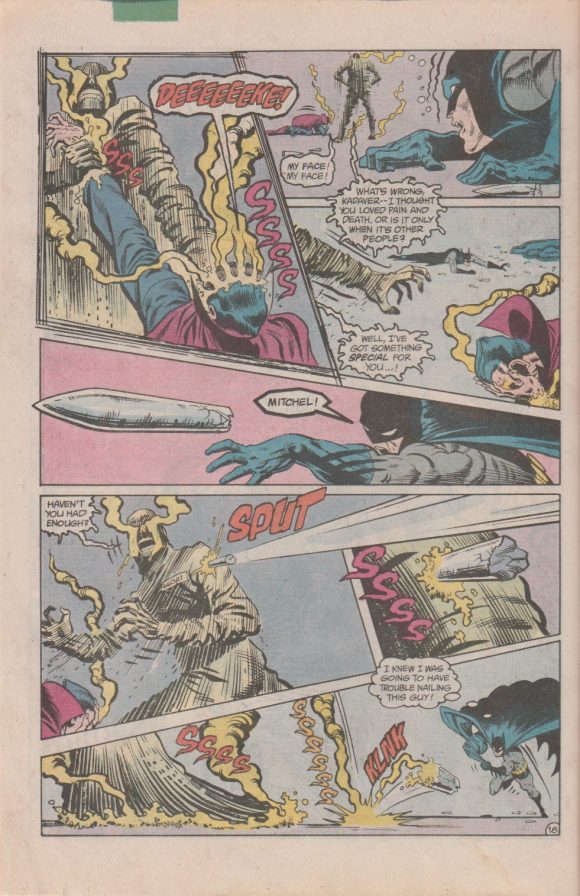
Breyfogle’s dynamic, border-breaking panel layouts only add to the atmospheric intensity. The cover of Issue #587 is now hailed as one of Breyfogle’s most iconic Batman images, captured in three dimensions in DC Collectibles’ Batman: Black and White statue line.
—
11. “Aborigine” (Detective Comics #591, October 1988). US pop culture had a brief love affair with Australia in the late ’80s. Paul Hogan’s Crocodile Dundee was a massive box office hit in 1986, and in 1987, Australian band Midnight Oil broke through the international charts with their anthem for indigenous people, “Beds Are Burning”. Having heard that song on the radio, and seen the video repeatedly on MTV (remember when they showed music videos?), for me the song acted as a soundtrack to this tale by Grant and Wagner, where an indigenous guardian travels to Gotham to retrieve a sacred artifact, and take revenge on those who killed his people for it.
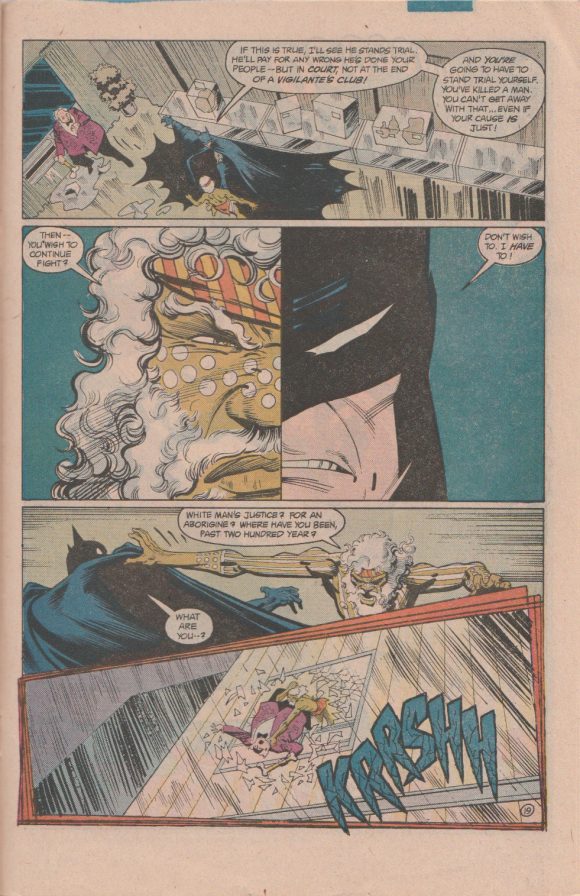
Breyfogle draws the guardian in question, Umbaluru, as a lean but powerful force of nature, but with a sympathetic face. Although Batman has to worry about due process of law, Breyfogle’s art puts the reader clearly on the side of the stalker out to set things right for a culture so deeply wronged.
—
10. “The Fear” (Detective Comics #592-593, Nov.-Dec. 1988). Batman may have battled an asylum full of villains before, but he had never encountered someone as disturbingly insane as Cornelius Stirk, as presented by Wagner, Grant and Breyfogle. Stirk’s insanity radiates from Breyfogle’s pages: He deftly illustrates Stirk’s power of mental projection, able to change his appearance from everyone from a beautiful woman, to Abe Lincoln, to even Jesus!
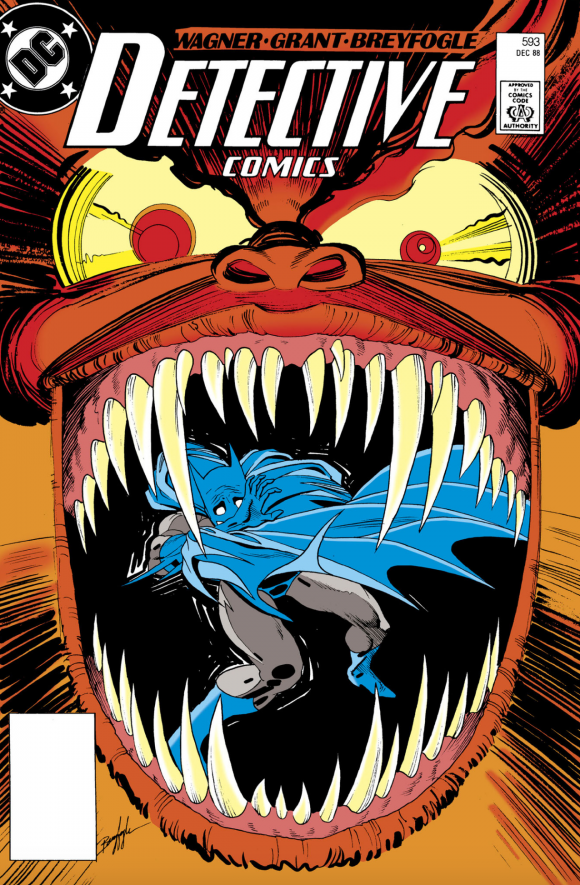
But the truly memorable images are of Stirk’s mental tortures unleashed, like the cover of Issue #593, with Batman trapped inside Stirk’s shark-like mouth. Only the image of Batman busting free of his shackles to save an innocent man is more powerful.
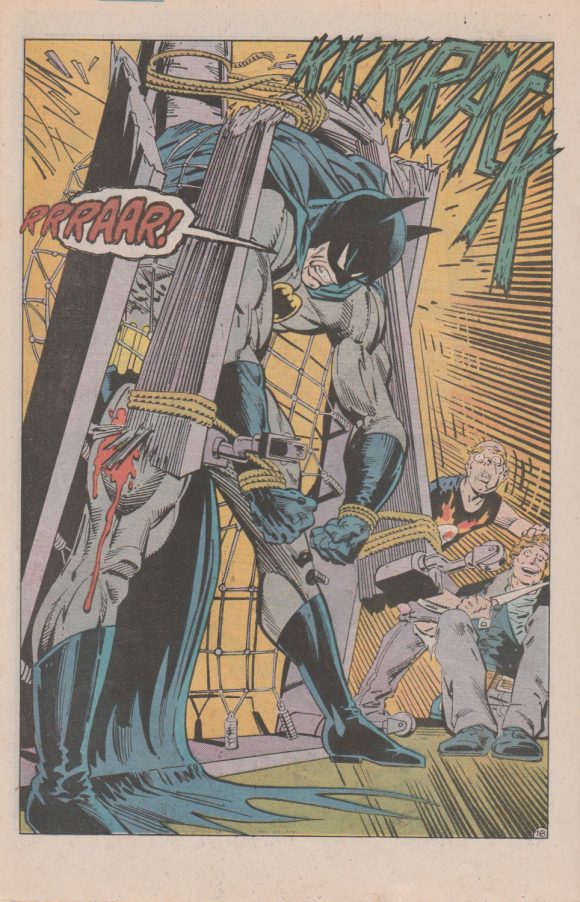
—
9. “Rite of Passage” (Detective Comics #618-621, Summer 1990). In this story by Grant, Batman travels to Haiti in the hopes of saving Tim Drake’s kidnapped parents. Breyfogle draws the people and locales of Haiti with the same skill and energy he’s brought to Gotham. Batman’s anger over his failure to save Tim’s mother from the Obeah Man’s poison is palpable, as he rips through the villain’s army in fury. But perhaps the best sequence is when Bruce Wayne consoles a grieving Tim, and he imagines the Batman as a monstrous demon, about to consume him.
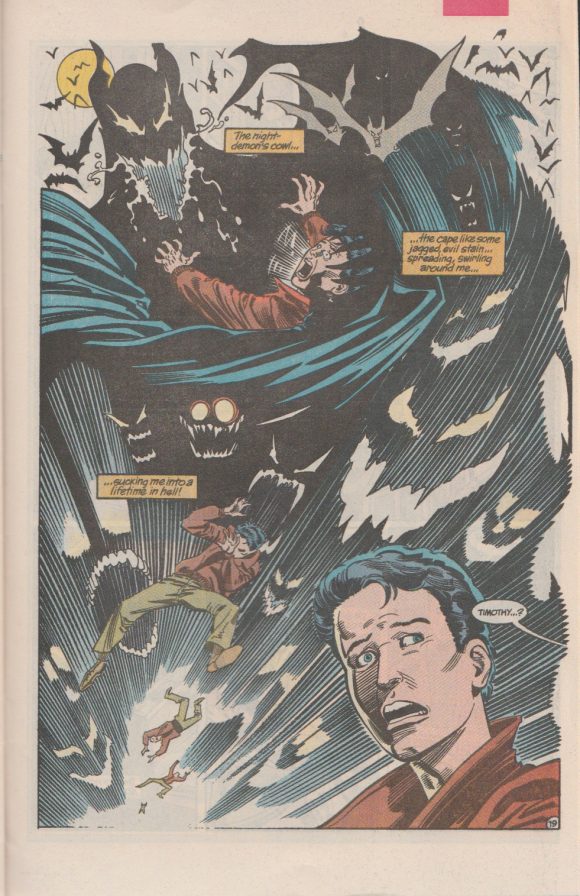
—
8. “A Clash of Symbols” (Detective Comics #617, Early July 1990). Sandwiched between Batman #450 and #451, the Joker’s return following the tragic events of A Death In the Family, this story finds Batman reminiscing on an earlier encounter with the Clown Prince of Crime. This is Breyfogle’s only chance to draw a full-on Joker story, but he makes the most of it, giving us a Harlequin of Hate who is mercurially mad, often appearing as only eyes and a row of teeth amid a mass of shadows. The double-page spread where Batman kicks through the windshield of the Joker’s roadster, a giant symbolic bat behind him, is an image for the ages. It’s a shame this story by Grant, Breyfogle and inker Steve Mitchell is often overlooked in the history of great Batman/Joker dust-ups. It deserves to be toward the top of that heap.
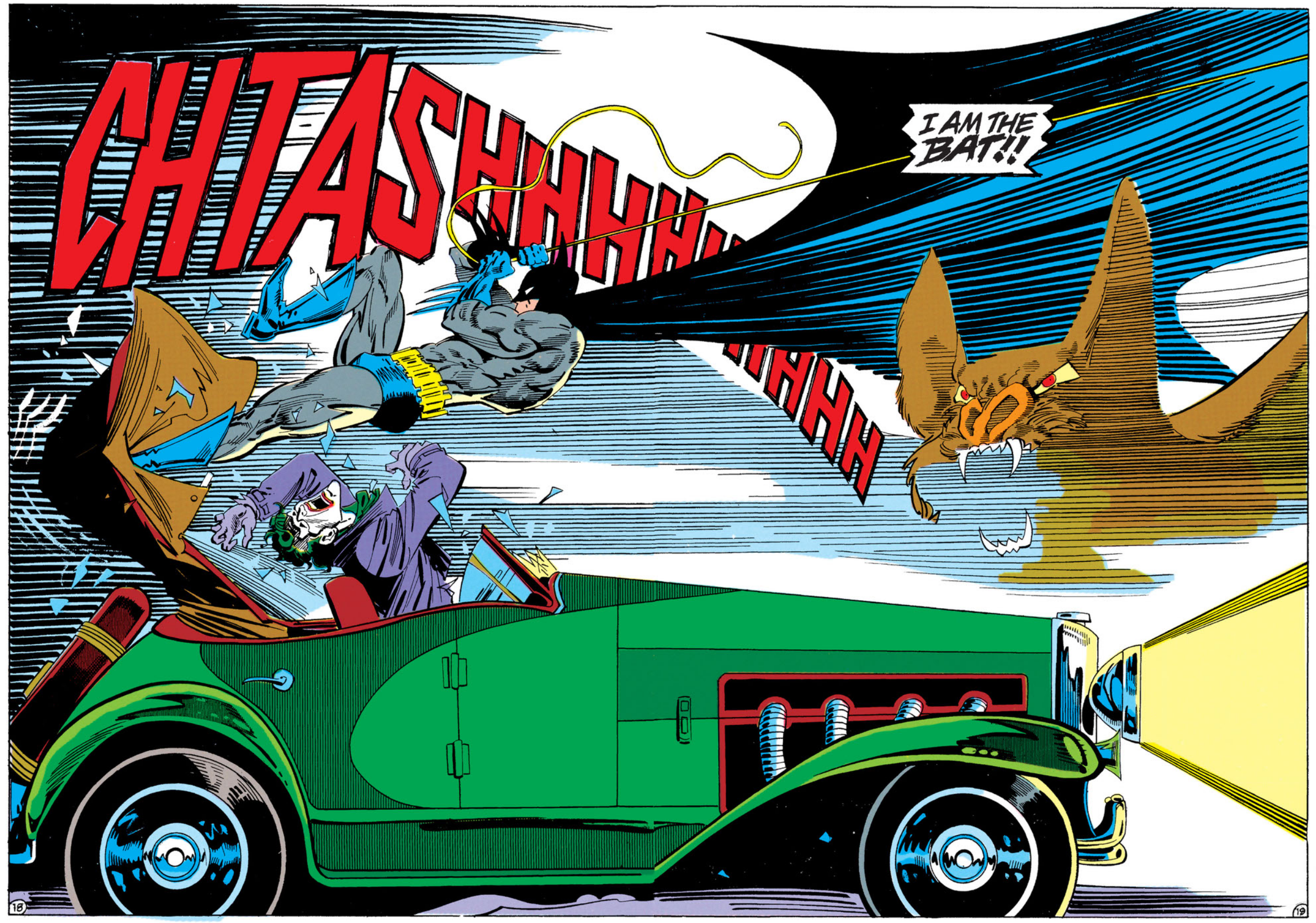
—
7. Batman: Holy Terror (1991). Although Batman: Gotham by Gaslight is now considered the beginning of the Elseworlds brand, the first book officially released under the imprint was Batman: Holy Terror, by Breyfogle and novelist/screenwriter and occasional comic scribe Alan Brennert. Set in a theocratic United States, the prestige one-shot finds Bruce Wayne studying for the priesthood, and uncovering the church government has been behind such atrocities as ordering his parents murdered, and imprisoning and experimenting on several familiar super-powered beings.
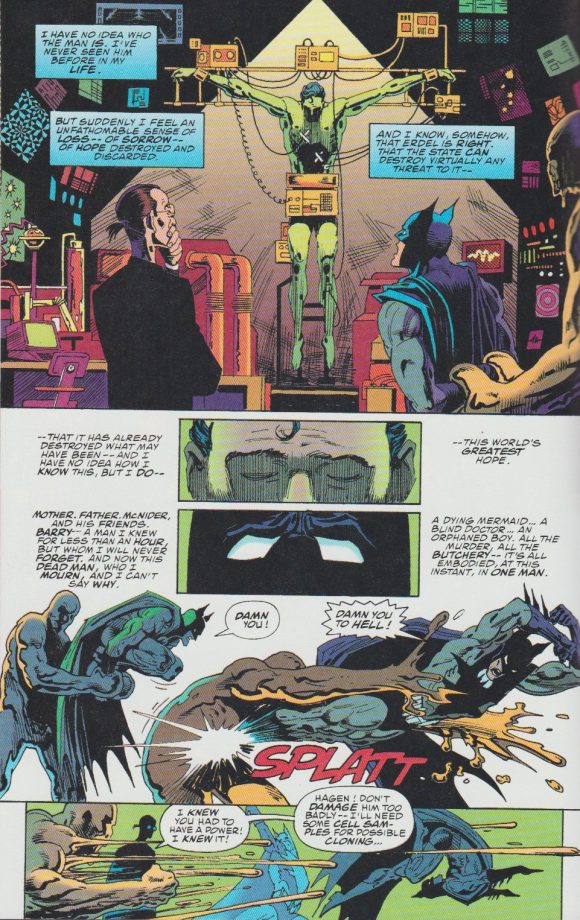
Breyfogle gets to cut loose on this project, creating a Gotham City that that ups the gothic to never-before-seen levels, looking like one giant cathedral that stretches for miles and miles. His Batman redesign incorporates Bruce’s priest collar, and his ears evoke a bishop’s miter. His interpretation of the tragic fate of some of the DCU’s greatest heroes is truly heartbreaking.
In his introduction to Tales of the Batman: Alan Brennert, the author said “Norm Breyfogle’s ornate, magnificent designs truly brought this alternate world to life, far exceeding what I had written in the script.”
—
6. “Anarky in Gotham City” (Detective Comics #608-609, Fall 1989). One of Breyfogle and Grant’s most enduring gifts to Batman, Anarky made his debut in this storyline. Grant borrowed quite a bit from V for Vendetta, but Breyfogle gave the character his own distinct charm with his solid red cloak and hat, and unmoving gold face. As the mystery mounts of just who this mysterious vigilante anti-hero might be, Breyfogle delivers the goods, first when Batman removes the gold mask, only to find a Styrofoam mannequin head beneath, and then finally the revelation that Batman’s new rival is just a 12 year-old Lonnie Machin, hiding in the closet. And Lonnie actually looks like he’s 12, something hard to pull off for many comic artists.
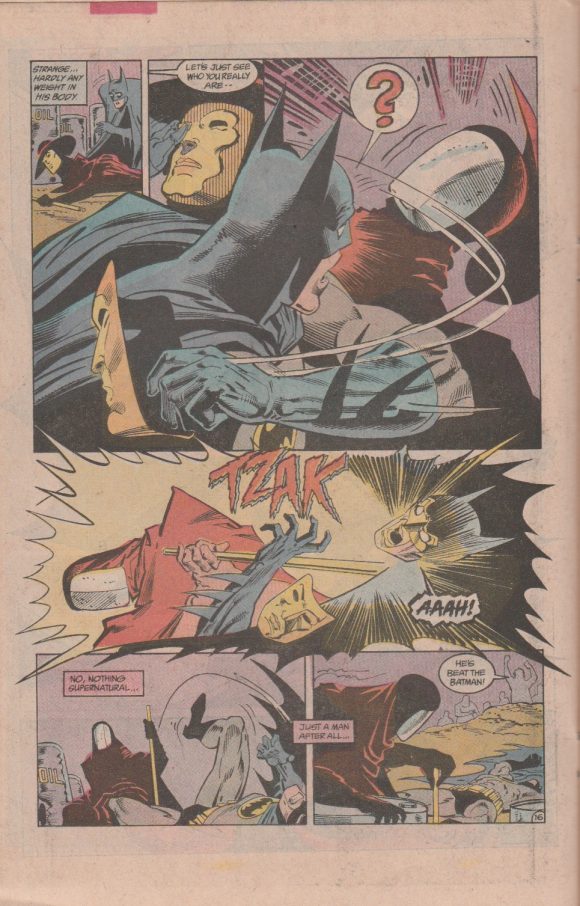
The real zinger, though, is the last panel, as Batman swings away from the roof of police HQ, and a pipe-dropping Commissioner Gordon notices the anarchy symbol spray-painted on the back of Batman’s cape!
—
5. “Identity Crisis” (Batman #455-457, October-December 1990). Although introduced by Marv Wolfman during the Batman: Year Three and A Lonely Place of Dying storylines, it was Grant and Breyfogle who got to complete Tim Drake’s journey, and present him as Robin to the world.
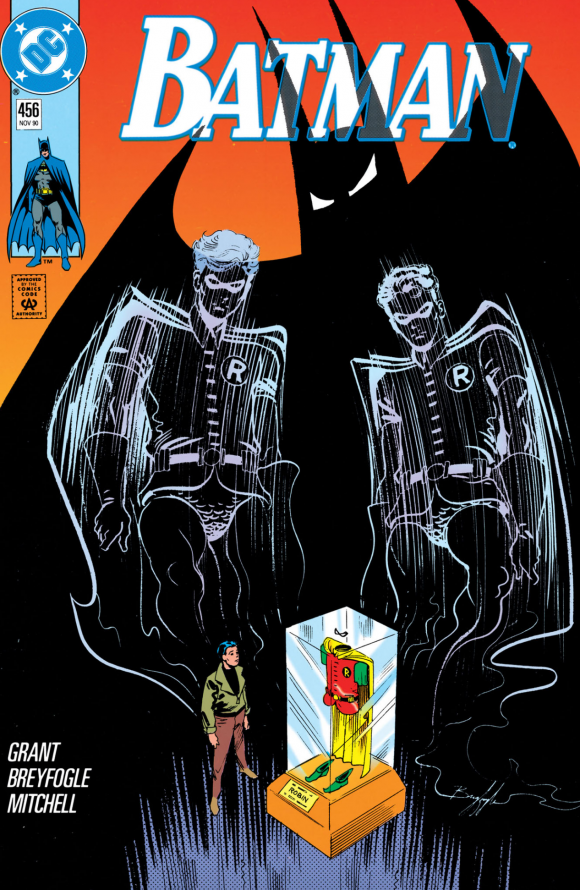
Breyfogle’s knack for drawing symbolic, ethereal elements comes in handy, as the legacy of the two previous Robins hang heavy over Tim’s head throughout the story, as seen on the cover of Batman #456. He also manages to draw the Scarecrow’s fear-induced hallucinations better than just about anyone, but brings things back to reality when a ski-mask-wearing Tim defies Batman’s orders and saves both the Dark Knight and Vicki Vale in a thrilling action climax.

Of course the real shining moment is Tim’s debut in his new, Neal Adams-designed Robin costume. It rarely looked better than under Breyfogle’s pencils.
—
4. “The Mud Pack” (Detective Comics #604-607, Summer 1989). Grant and Breyfogle may have been bypassed for Batman’s official 50th anniversary adventure in Detective #598-600 (by Batman screenwriter Sam Hamm and Denys Cowan), but they managed to create their own opus in 1989, the Year of the Bat.
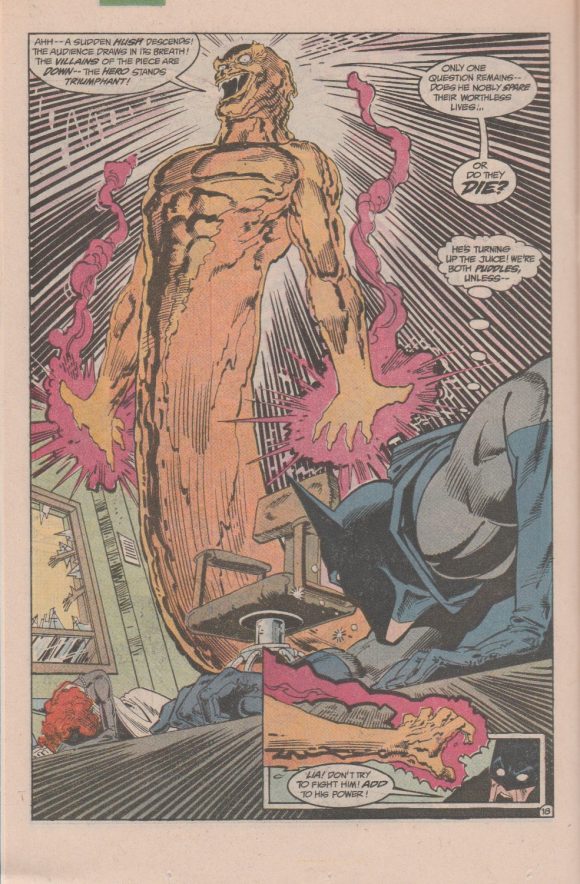
“The Mudpack” brought together all the Clayfaces (well, Matt Hagen was a bit too dead to participate) in a revenge plot against the Dark Knight. Or at least that’s what it seemed, until original Clayface Basil Karlo revealed his goal of becoming the ultimate Clayface. Breyfogle’s depiction of Karlo as a true monster is a highlight of the story; his physical power and arrogant madness burst through the panel borders as he battles the Caped Crusader and his former Outsiders teammate, Looker.
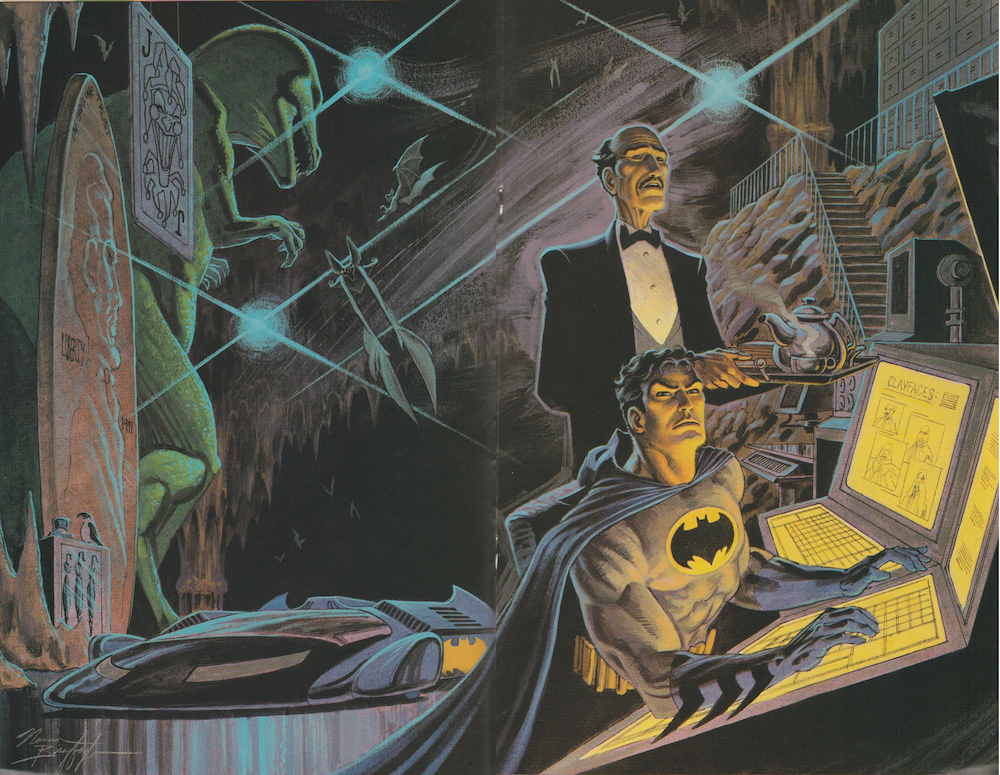
Poster from Detective Comics #607
But perhaps his most admirable artistic feat is warmly depicting the burgeoning romance between Preston Payne (Clayface III) and Lady Clay, who find peace at last in each other’s oozing arms. As an added bonus, Issues #604 and #607 feature fully painted, pullout posters by Breyfogle, depicting Batman swinging through the Gotham night, and working in the Batcave, respectively.
—
3. “The Last Arkham” (Batman: Shadow of the Bat #1-4, June-September, 1992). A testament to the tremendous popularity of the Grant/Breyfogle team was for them to be awarded their own Bat-title, where they could continue their psychologically driven stories. What better place to start than Arkham Asylum, where at the end of the first issue, we find that Batman has now become one of the inmates!
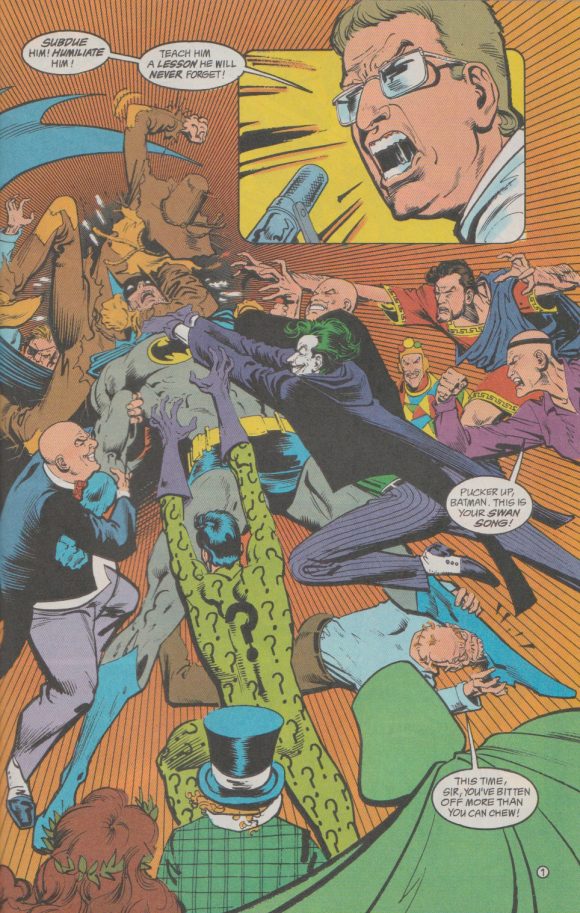
Breyfogle gets a chance to draw just about every classic rogue in action, as well as returning partner Nightwing. Yet the real highlight is yet another Grant/Breyfogle villain added to the pantheon of rogues: Mr. Zsasz, the sadistic serial killer who tallies his victims by marking cuts on his own body.
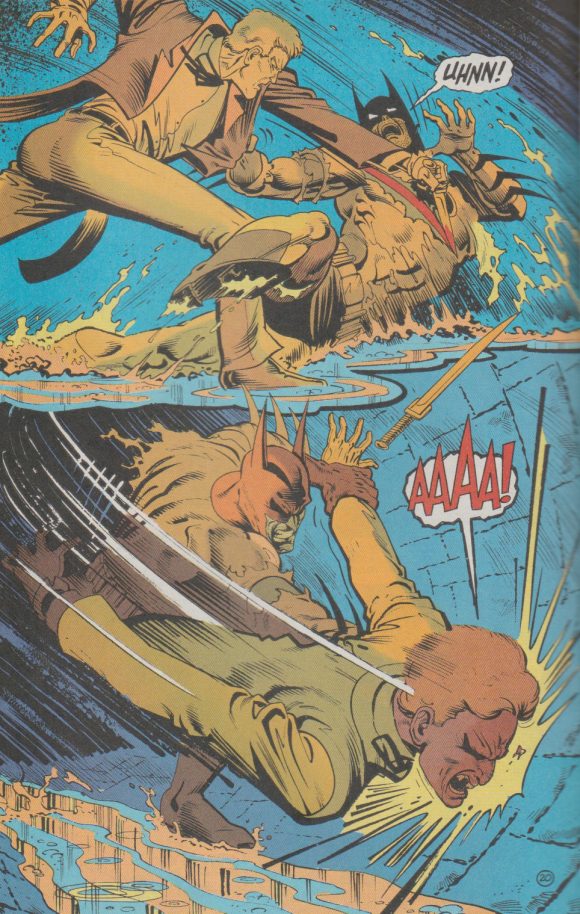
Throughout the first two issues, Breyfogle helps sell the idea that perhaps Batman really has gone mad, even if we the readers know better. The climactic battle between Batman, Nightwing and Zsasz in the sewers below Arkham is another action-packed triumph. When Batman slams Zsasz’s head into the bricks, you can almost feel that lost tooth.
—
2. “Fever/Fever Break” (Detective Comics #583-584, February/March 1988). Of all the foes Grant, Wagner and Breyfogle introduced, none had more (wooden?) legs than the Ventriloquist and Scarface. The duo seemed cut from the same cloth as Batman’s gimmicky villains of the ’40s, with a deeply psychological twist: The dummy was in charge.
No other artist ever quite sold the wood-and-paint texture of Scarface’s visage, and the repeated spinning-head trick Breyfogle utilized showed just how unhinged the dummy, and by proxy, his handler, Arnold Wesker, actually were. When Batman gets a face full of the Fever drug they are pushing in the story’s climax, Breyfogle (along with underrated master colorist Adrienne Roy) depict a world that is on fire from Batman’s perspective. You can almost feel the heat coming off the pages.
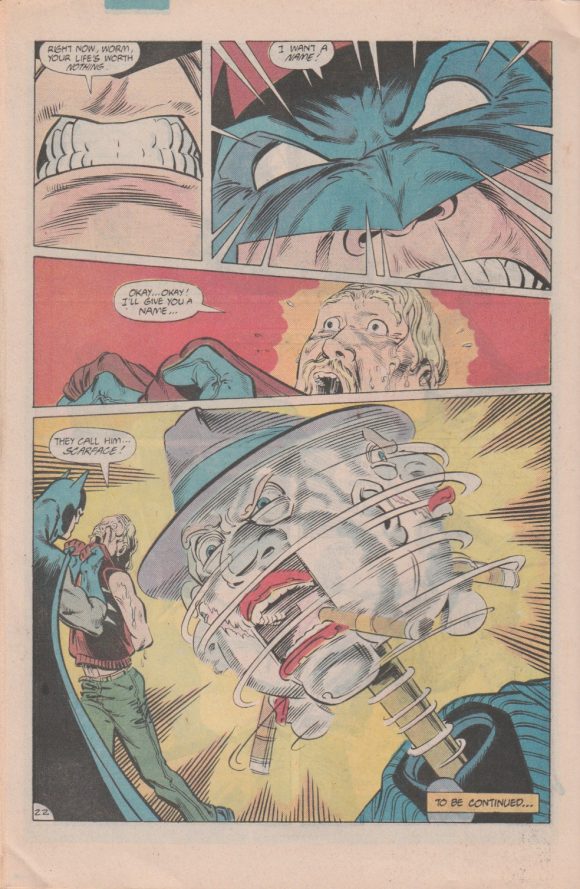
So impressive was this double act that the producers of Batman: The Animated Series drafted them for placement in their rogues gallery just a few years later, and they fit right in with the likes of Joker, Penguin, Riddler and Two-Face. Just as Breyfogle earned his place among the greatest Batman artists, and by extension, the greatest artists in comics, like Sprang, Infantino, Adams, Aparo, Rogers and Newton.
—
1. Batman: Birth of the Demon (1992). Perhaps Breyfogle’s crowning achievement with the character, Batman: Birth of the Demon teamed him with his usual editor, Denny O’Neil, this time writing, at last, the heretofore unknown origin of his greatest contribution to Batman lore, Ra’s al Ghul.
Breyfogle’s fully painted art is nothing short of breathtaking, all the more impressive because it loses none of the unique energy his pencils normally convey. With the majority of the story set in flashback in the Middle East, and nary a costumed crimefighter in sight, Breyfogle brings vibrant life to O’Neil’s tale of a good man wronged by those in power at every turn, ultimately believing it is he who should be mankind’s ultimate savior, no matter the cost.

The epic showdown between the two old foes at the tale’s end climaxes with Breyfogle’s stunning reveal of a burned and nearly dead Bruce Wayne, a shovel embedded in his chest, determined to take his adversary down with him. Once seen, it can never be forgotten, much like the artist himself.
—
MORE
— The TOP 13 NORM BREYFOGLE Covers — RANKED. Click here.
— NORM BREYFOGLE: In His Own Words. Click here.
—
Chris Franklin co-hosts several shows on the Fire and Water Podcast Network, including Batman Knightcast (with Ryan Daly), and Super Mates and JLUCast (with his wife Cindy). Like 13th Dimension’s own Dan Greenfield, he contributed an essay to Zlonk! Zok! Zowie! The Subterranean Blue Grotto Guide to Batman ’66 – Season One, and is providing an essay and illustrations for the forthcoming Biff! Bam! Eee-Yow! The Subterranean Blue Grotto Guide to Batman ’66 – Season Two.

February 27, 2021
I read most of these issues in real time and absolutely adored Breyfogle’s work. Great list, Chris – makes me want to reread!
February 27, 2021
Need to revisit this particular era….great talent.
February 27, 2021
Shadow of the Bat #13, “The Nobody,” is one of my favorites. Norm was such an incredible talent.
March 15, 2022
I love that one too, especially the speech at the end. I nearly cried the first time I read it. Great stuff.
February 27, 2021
Happy birthday to the late Mr. Breyfogle.
February 27, 2021
Great list! Norm Breyfogle will always be my Batman artist. His cover to Detective 603 is one of my all time favorite comic covers.
March 2, 2021
An incredible talent. If anyone from DC is reading this, I’m still waiting on ‘Legends of the Dark Knight: Norm Breyfogle Vol.3 HC!
March 10, 2021
I’d include the 3 part Rat Catcher story, that was as near perfect a take as I’ve read. His subsequent appearances never captured the strength of the character, as his debut did.
And who can forget the “backwards” hand of a fallen Batman, on one of the covers?
March 10, 2021
Ratcather 3 parter did it for me!
March 2, 2022
Love those 2 Breyfogle/Batman HCs. Any chance DC does a 3rd?
November 8, 2024
is the ones that look older stories that so far have not been reprinted??